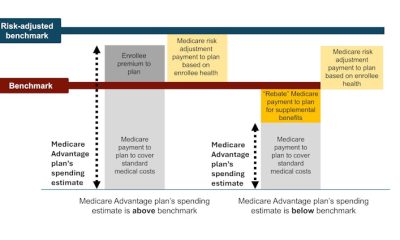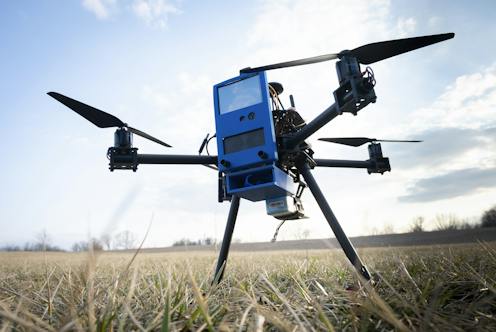Drone deliveries would be particularly effective in places where emergency responders can’t respond quickly. Vincent Walter/Purdue University, CC BY-NC-ND
An onlooker – even one without prior training – can successfully administer naloxone to an overdose victim within about a minute of a drone delivering the lifesaving opioid reversal agent. That’s the key finding of my team’s newly published study.
Naloxone is also known by the name brand Narcan.
The study involved 17 participants responding to a simulated overdose. Each simulation included an untrained participant who portrayed a bystander, a box of naloxone delivered by drone, a mannequin as the overdose victim, and a panicked observer. The latter added a sense of urgency by continually shouting at the bystander throughout the simulation.
Via a video playing on a screen carried by the drone, the bystander received instructions on how to use the naloxone, which is administered as a nasal spray. We timed each participant on how long it took them to correctly give the medication during this crisis moment.
Our trial revealed that the average time for someone to remove the naloxone from the drone, view the video and administer the medication was 62 seconds.
Simulation of the first demonstration flight of the drone’s delivery of naloxone to an overdose victim.
Why it matters
Such a scenario could be a lifesaver, particularly in places where an emergency medical services, or EMS, team is either not available or slower than a drone delivery. This includes not only densely populated cities with traffic congestion, but more remote areas.
The average response time for an ambulance in rural America is 14 minutes. Nationally, the average ambulance response time is seven minutes.
Either way, it’s too late to help an opioid user who has stopped breathing. Brain damage occurs in about four minutes, and death in six.
But get a drone to an overdose victim within three minutes, and add one more minute for someone to remove and administer the drug, and there’s a chance to save their life and even prevent brain injury.
More than 75,000 people in the U.S. died in 2022 from an opioid overdose. A drone network that could deliver naloxone fast enough to ensure quick administration of the drug could save thousands of lives every year.
The technology, although nascent, is here. Amazon is already using drones to deliver packages in select U.S. cities and in other countries. Since 2011, drones have been delivering blood to remote hospitals in Africa.
What still isn’t known
Deciding where to distribute drone stations across an area is the next step. But if emergency service planners can first determine how long it takes to dispense the medication, informed by our study and others, then they will know how much time a drone has to get to the scene.
Our trial provides a template for future studies – and it comes closer than other controlled trials to simulating the surprise and anxiety experienced by a bystander during an overdose incident.
To the best of our knowledge, there are two previous human trials from the U.S. using drones for medical intervention. But both studies used trained participants who were familiar with the interventions and did not require in-the-moment training on how to use the device.
What’s next
As this technology matures, engineering teams will continue to improve the drone’s design and its methods of instruction.
Replicating this study with a diverse population and larger groups of people will be crucial to confirm the time needed to administer the drug after the drone lands.
Another issue for future study will be addressing community acceptance of medical drones. As they fly over houses, drones still cause fear and uncertainty in many neighborhoods. Adequate education will be needed to prepare communities for these potentially life-saving deliveries.
The Research Brief is a short take on interesting academic work.
Nicole Adams has received funding from the Substance Use and Mental Health Service Administration (SAMHSA), the US Department of Agriculture (USDA), the National Council of State Boards of Nursing (NCSBN), as well as internal University seed grants.













